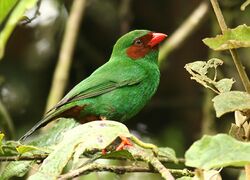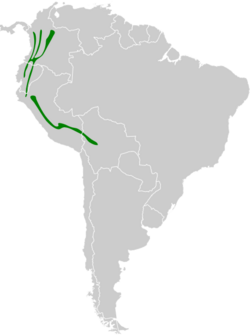Biology:Grass-green tanager
| Grass-green tanager | |
|---|---|

| |
| Scientific classification | |
| Domain: | Eukaryota |
| Kingdom: | Animalia |
| Phylum: | Chordata |
| Class: | Aves |
| Order: | Passeriformes |
| Family: | Thraupidae |
| Genus: | Chlorornis Reichenbach, 1850 |
| Species: | C. riefferii
|
| Binomial name | |
| Chlorornis riefferii (Boissonneau, 1840)
| |

| |
The grass-green tanager (Chlorornis riefferii) is a small South America bird in the tanager family Thraupidae. It is the only member of the genus Chlorornis.
The grass-green tanager is 20 cm in length and weighs 53g. It lives in and around subtropical and temperate forests in the Andes of Colombia, Ecuador, Bolivia and Peru at elevations of 1500–3350 m.
It is seen in pairs or in groups of 3-6 individuals. It forages mostly on upper half of short trees and eats fruits and insects. It is known to perch almost horizontally. Its nest is made of mosses and ferns, and its eggs are gray with light purple-grey dots.
Taxonomy
The grass-green tanager was formally described in 1840 by the French ornithologist Auguste Boissonneau from a specimen collected near Bogotá in Colombia. He coined the binomial name Tanagra riefferii.[2][3] The species is now the only member of the genus Chlorornis that was introduced in 1850 by the German naturalist Ludwig Reichenbach.[4][5] The genus name combines the Ancient Greek khlōros meaning "green" and ornis meaning "bird". The specific epithet was chosen to honour the collector Gabriel Rieffer.[6] The grass-green tanager has a sister relationship to the genus Cnemathraupis containing the black-chested mountain tanager and the golden-backed mountain tanager.[7]
Five subspecies are recognised:[5]
- C. r. riefferii (Boissonneau, 1840) – Colombia and Ecuador
- C. r. dilutus Zimmer, JT, 1947 – north Peru
- C. r. elegans (Tschudi, 1844) – central Peru
- C. r. celatus Zimmer, JT, 1947 – south Peru
- C. r. bolivianus (Berlepsch, 1912) – west Bolivia
References
- ↑ BirdLife International (2018). "Chlorornis riefferii". IUCN Red List of Threatened Species 2018: e.T22722150A132012843. doi:10.2305/IUCN.UK.2018-2.RLTS.T22722150A132012843.en. https://www.iucnredlist.org/species/22722150/132012843. Retrieved 12 November 2021.
- ↑ Boissonneau, Auguste (1840). "Oiseaux nouveaux ou peu connus de Santa-Fé de Bogota" (in French). Revue Zoologique 3: 2–18 [3]. https://www.biodiversitylibrary.org/page/13714038.
- ↑ Paynter, Raymond A. Jr, ed (1970). Check-List of Birds of the World. 13. Cambridge, Massachusetts: Museum of Comparative Zoology. p. 252. https://www.biodiversitylibrary.org/page/14483487.
- ↑ Reichenbach, Ludwig (1850) (in German). Avium Systema Naturale. 1. Dresden and Leipzig: Friedrich Hofmeister. Plate LXXVII. https://www.biodiversitylibrary.org/page/47618519. For the publication date see: Dickinson, E.C.; Overstreet, L.K.; Dowsett, R.J.; Bruce, M.D. (2011). Priority! The Dating of Scientific Names in Ornithology: a Directory to the literature and its reviewers. Northampton, UK: Aves Press. p. 133. ISBN 978-0-9568611-1-5. https://www.researchgate.net/publication/267763194.
- ↑ 5.0 5.1 Gill, Frank; Donsker, David; Rasmussen, Pamela, eds (July 2020). "Tanagers and allies". IOC World Bird List Version 10.2. International Ornithologists' Union. https://www.worldbirdnames.org/bow/tanagers/.
- ↑ Jobling, James A. (2010). The Helm Dictionary of Scientific Bird Names. London: Christopher Helm. pp. 103, 336. ISBN 978-1-4081-2501-4.
- ↑ Burns, K.J.; Shultz, A.J.; Title, P.O.; Mason, N.A.; Barker, F.K.; Klicka, J.; Lanyon, S.M.; Lovette, I.J. (2014). "Phylogenetics and diversification of tanagers (Passeriformes: Thraupidae), the largest radiation of Neotropical songbirds". Molecular Phylogenetics and Evolution 75: 41–77. doi:10.1016/j.ympev.2014.02.006. PMID 24583021. https://digitalcommons.lsu.edu/cgi/viewcontent.cgi?article=3613&context=biosci_pubs.
External links
Wikidata ☰ Q263341 entry
 |


